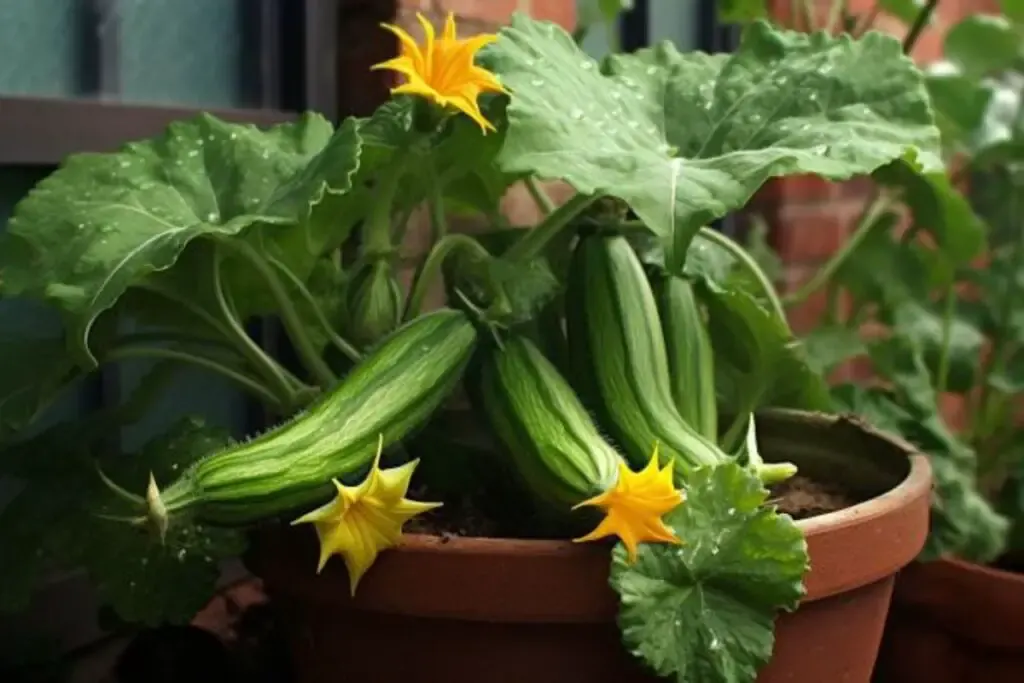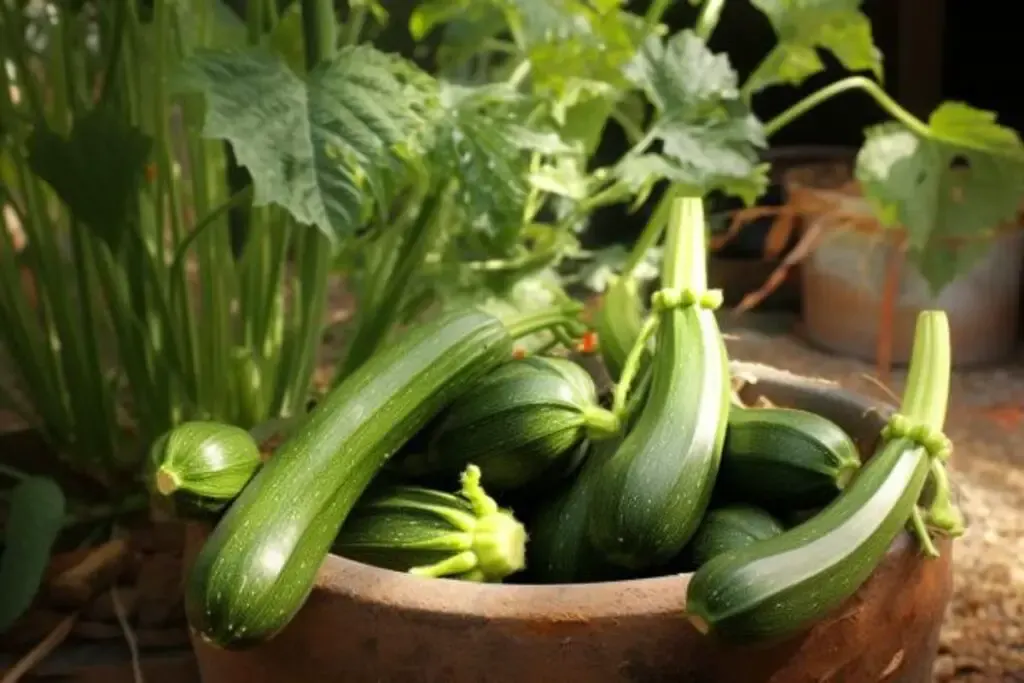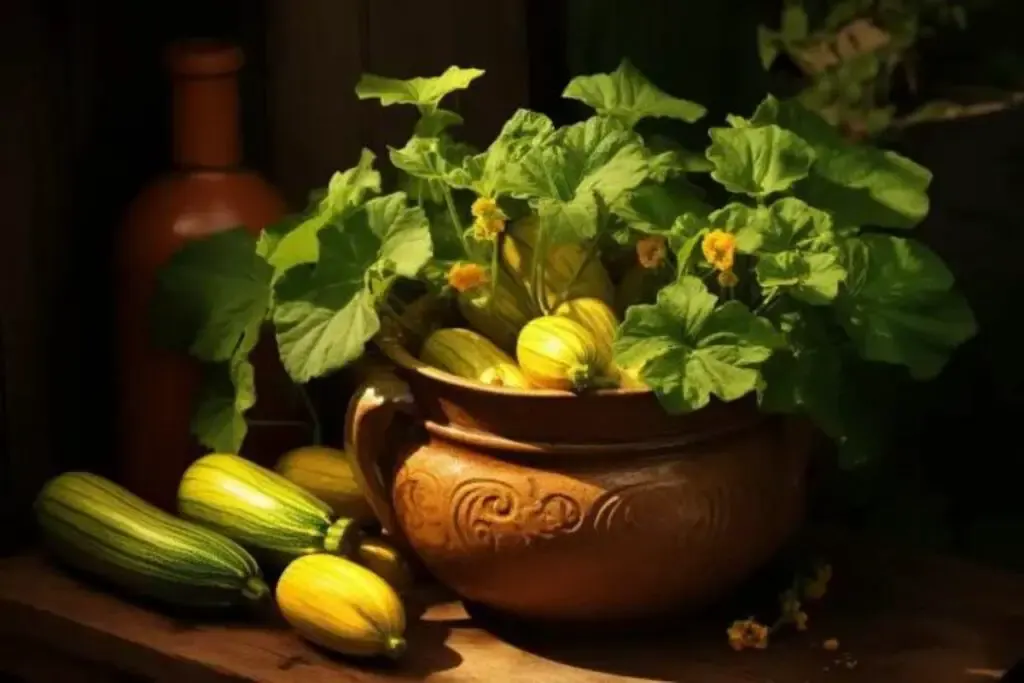Gardening enthusiasts often imagine vast, sprawling vegetable patches when they think of growing their own food, but what if all you have is a sunny balcony or a modest patio?
Fear not! Zucchini, a bountiful summer squash, is surprisingly well-suited to container gardening.
I’m excited to share some tips and tricks that I’ve gathered over the years to help you grow zucchini in pots like a pro. Let’s dig in!
Does Zucchini Grow Well in Pots?
Absolutely! Zucchini plants are quite adaptable and can flourish in pots as long as they are provided with enough space to grow and the right care. Growing zucchini in containers is a fantastic option for those with limited garden space.
Not only does it make the plants more manageable, but it also can help combat soil-borne diseases and pests. With diligent watering, proper feeding, and consistent harvesting, you can enjoy a bountiful harvest right from your porch or balcony.
When selecting a container, size does matter. A pot that’s at least 18-24 inches in diameter and deep will give the zucchini ample room to expand its roots. Ensure there are adequate drainage holes at the bottom because, while zucchini loves moisture, waterlogged soil can spell disaster.
Let’s not forget, that containers make it easier to control soil quality and nutrient levels, giving your zucchini the perfect environment to thrive.
Best Zucchini Varieties for Pots
Choosing the right variety is crucial when it comes to growing zucchini in containers. Some zucchini plants sprawl extensively, while others are bred to be more compact.
Here, we’ll focus on varieties that are known for their container-friendly habits.
1. Patio Star

Patio Star is a personal favorite for small-space gardeners. This compact variety doesn’t skimp on production. It’s designed for pot life, with a bushy growth habit that doesn’t require the sprawling room that other zucchini plants do.
I’ve found that it’s incredibly generous in its yield, producing beautiful, dark green zucchini that are as delicious as they are easy to grow. Patio Star has never disappointed me, and it’s perfect for a sunny spot on your deck or patio.
2. Astia

Astia is a French bush variety that is notably well-suited to container gardening and doesn’t need pollinators to produce a hefty crop.
What sets Astia apart is its vigor and ability to thrive in a pot. Its non-rambling, upright growth habit makes it ideal for more confined spaces. In my experience, Astia zucchini have a superb flavor and texture, making them a top choice for culinary use.
3. Gold Rush

If you’re looking to add some color to your pot garden, Gold Rush is the go-to. This award-winning hybrid produces eye-catching golden-yellow fruits that are tender and tasty.
It’s a bush-type zucchini, which means it grows more vertically than horizontally – a trait that you’ll appreciate when space is at a premium. In my garden, Gold Rush is always a conversation starter due to its vibrant color and delightful taste.
Growing zucchini in pots can be a rewarding venture, especially when you choose varieties that are bred for success in confined spaces. Remember to provide ample sunlight, consistent water, and regular feeding, and you’ll be on your way to harvesting fresh zucchini throughout the season.
How to Grow and Care For Zucchini in Pots
Growing zucchini in pots doesn’t just save space—it also offers the pleasure of watching your garden thrive right on your balcony or patio. But like any good thing in the garden, it requires the right blend of care and conditions.
Let me walk you through the steps and tips that have served me well over many gardening seasons.
Planting
Planting zucchini in pots is all about timing and technique. Start your seeds indoors about 2 to 4 weeks before the last expected frost date, or plant them directly into your outdoor pots when the weather warms up.
I like to use biodegradable pots for indoor starts to minimize root disturbance when transplanting. Sow two seeds per pot about an inch deep, and after germination, snip off the weaker seedling to let the stronger one thrive.
Pot Size
Size is non-negotiable here. Zucchini plants are heavy feeders with robust root systems. Choose a large pot, at least 18 inches deep and wide, to give your plant room to grow.
A smaller pot will stress the plant by restricting its roots and limiting available nutrients. Trust me, investing in a larger pot upfront is worth the healthy harvest later on.
Light
Zucchini plants are sun lovers and require plenty of light to produce those delicious squashes. Aim for at least 6 to 8 hours of full sun each day.
In my own balcony garden, I make sure my zucchini pots get the sunniest spot. If you’re in a region with extremely hot summers, some afternoon shade can be beneficial to prevent overheating.
Remember, the more light your zucchini gets, the more fruit it will produce. So, finding that sunny spot is key to a bountiful harvest.
Soil
The right soil mix can make a world of difference in growing healthy zucchini in pots. These plants prefer a well-draining, nutrient-rich soil.
I like to mix high-quality potting soil with compost or aged manure to give the plants a good start. Zucchini also prefers slightly acidic to neutral soil (pH between 6.0 and 7.0). Ensuring your soil meets these conditions will set the stage for a thriving zucchini plant.
Water
Consistent watering is crucial for zucchini, especially when they are grown in pots. The goal is to keep the soil evenly moist but not soggy. I usually check the soil moisture every day by sticking my finger an inch deep into the soil. If it feels dry, it’s time to water.
Over-watering can lead to root rot while under-watering can stress the plant and affect fruit production. Also, water at the base of the plant to avoid wetting the leaves, which can lead to fungal diseases.
Temperature and Humidity
Zucchini plants thrive in warm conditions. The ideal temperature range for growing zucchini is between 70°F and 95°F. They can tolerate a bit of variation, but consistent temperatures below 60°F can impede growth and fruit development.
In terms of humidity, zucchini plants are pretty adaptable but perform best in moderate conditions. Extreme humidity can lead to issues like powdery mildew, so it’s important to ensure good air circulation around your pots.
If you live in a cooler climate, consider starting your seeds indoors or using a greenhouse to protect young plants from cold temperatures.
Fertilizer
Start with a balanced, slow-release fertilizer when you plant, and follow up with a liquid feed every 4 to 6 weeks. Zucchini plants are particularly hungry for nitrogen and potassium, which support leaf growth and fruit development. But don’t overdo it—too much fertilizer can lead to lush foliage but poor fruiting.
By following these steps, you’re well on your way to growing zucchini like an expert. Remember, container gardening with zucchini isn’t just about harvesting delicious squash—it’s about enjoying the process and learning along the way. Happy gardening!
Pruning Potted Zucchini
Pruning might not be the first thing that comes to mind when you think of zucchini, but it can significantly impact the health and yield of your plant. Here’s the scoop: Regularly removing old leaves and any diseased or damaged foliage can improve air circulation and reduce the risk of fungal diseases.
When the plant is young, focus on encouraging a strong, central stem by pinching off any side shoots. As it grows, remove lower leaves that touch the ground to prevent them from trapping moisture or inviting pests. Always use clean, sharp scissors or pruning shears for clean cuts that heal quickly.
Now, don’t get overzealous with the snipping. Zucchini leaves are like solar panels, gathering sunlight to fuel growth and fruit production. Just remove what’s necessary, and you’ll keep your zucchini happy and productive.
Overwintering
Let’s be real: Zucchini is a warm-season crop, which means it typically doesn’t overwinter. Once the temperatures dip, it’s usually time to say goodbye. However, in milder climates or with proper protection, you can sometimes extend the growing season a bit longer.
If you’re feeling adventurous, you can try overwintering a healthy zucchini plant indoors. Before the first frost, bring your pot inside to a sunny spot and maintain a steady temperature above 50°F. Cut back on watering, but don’t let the soil dry out completely. While you’re unlikely to see new growth, you might just give your plant a head start for the next season.
For most gardeners, though, the end of the season is an opportunity to collect seeds, compost the old plants, and start dreaming about next year’s garden. And that’s the beautiful cycle of gardening—there’s always next season to look forward to.

